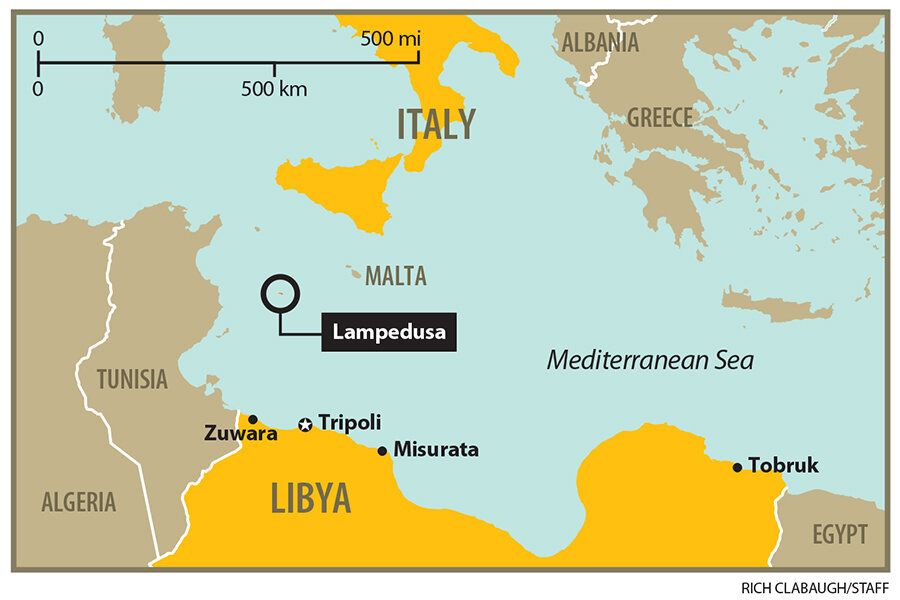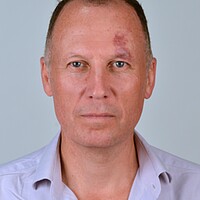For refugees, Libya proves perilous stepping stone to new life in Europe
Loading...
| Lampedusa, Italy
For Merhawi Tesfatsion, the shores of Libya represented the stepping stone to a new life in Europe. But the haunted look in the 15-year-old's eyes attest to the horrors he experienced to reach them, traveling without any family from his home in Eritrea, then across the Sahara, and finally north to the Mediterranean.
From his home in Asmara, the Eritrean capital, he crossed into Ethiopia. After a short detention from which he escaped, he entered Sudan. “We went through the desert by truck, but also by walking,” he says.
Finally reaching southern Libya did not provide relief. "If the police or soldiers catch you, they send you back to the camp in Ethiopia," he says.
Merhawi is safe now, having crossed the Mediterranean with his friends Tumzgi Haile and Frezghi Msgna on a people-smugglers' boat. Together, they await their future on the island of Lampedusa, Italy’s southern-most outpost, which lies less than 200 nautical miles off the coast of North Africa.
But the same cannot be said for tens of thousands of other refugees and asylum seekers still stuck in an increasingly dangerous Libya, waiting to board frequently unseaworthy boats to Italy.
With most Western countries closing their embassies in Libya, and few journalists daring to set foot in an increasingly lawless land, refugees’ accounts provide a vital glimpse into what is happening there. But the tales they tell of murderous soldiers, rampant violence, and abusive smugglers suggest that the dangers they face in Libya could be as bad – or worse – than the perils they faced in their homelands.
Record numbers from Africa, Middle East
Last year, a record 170,000 refugees flooded across the Mediterranean, traveling in large part out of Libya and arriving in Italy. In January, more than 3,500 refugees and migrants reached Italy from Libya, a 60 percent increase from January 2014. They come from all over Africa and the Middle East.
The Eritreans are fleeing a brutal regime which dragoons young men into military conscription and maintains a semi-permanent war footing with neighboring Ethiopia. Syrians and Iraqis are fleeing the war and atrocities committed by the self-described Islamic State, Palestinians the open prison that is Gaza, and West Africans the crushing poverty that has framed many of their lives.
The decision to trek across thousands of miles of desert and then clamber into a leaking former fishing boat or a fragile rubber dinghy may seem extreme. But for people who have had their houses destroyed by bombs or seen their families murdered by gunmen, there are few other options.
The vast majority of refugees make for Libya, where a power vacuum since the 2011 fall of dictator Muammar Qaddafi has enabled gangs of human traffickers to flourish. Libya, however, is spiraling ever further into chaos, with murderous Islamic State fighters making inroads in the east of the country and rival governments in Tripoli and Tobruk locked in a standoff. Islamist militias and desert tribes, meanwhile, fight for control of oil and gas resources.
As a result, refugees and asylum seekers are being subjected to much greater levels of violence in Libya, experts say.
“Refugees know they are going to risk their lives by trying to cross the Mediterranean, but they have no idea that the smugglers can be so violent. It comes as a big shock to them,” says Flavio Di Giacomo, a spokesman for the International Organization for Migration (IOM).
Sekou Balde, a migrant from Guinea-Bissau, was attacked by four Libyan soldiers armed with knives when they raided the house near Tripoli where he was living with other African immigrants.
Lifting up his sweatshirt, he reveals the six stab wounds he received all over his body, including on the arms and in the back.
“They said ‘where is your money?’ I said that I didn’t have any. Then they attacked me. My brother was shot dead in front of me – boom, boom – as well as two of my friends,” he says, sitting on a bare patch of rocky ground outside Lampedusa’s refugee center.
“Everyone in Libya is armed now,” says Djiby Diop, a 20-year-old from Senegal who spent three months in Libya dodging gunmen. “If you don’t work for them, they shoot you. If you don’t give them all your money, they shoot you. Or they shoot you just for fun.”
Night-time voyages
Smugglers are equally violent, beating refugees in order to make them more submissive as they wait for boats to take them across the Mediterranean to Italy, often on perilous night-time voyages.
A young Syrian refugee showed the Monitor video footage recorded on his smartphone which showed a group of refugees – also believed to be Syrian – being abused by smugglers armed with poles and automatic weapons.
In one piece of footage, male refugees are lined up one by one, ordered to raise their arms in the air, then viciously beaten on the back with a long pole. The degrading treatment of the refugees is believed also to have been intended to extort more money out of them for the boat crossing.
“If they had seen that I was filming, I would have been killed,” the teenager says in an interview on Lampedusa.
He says his family had paid $6,000 to have him taken by smuggling syndicates from Syria to Libya. He flew to Khartoum in Sudan and from there was taken by truck across the Sahara and into Libya, a journey that took two months.
“There were 30 people on the truck. I didn’t eat for four days because the food was dirty. I saw people die. They were pushed off the truck by the smugglers,” he says.
He was imprisoned in a police station in southern Libya for 10 days. On his release, he made his way north to the coast and was held in an abandoned house before being packed into a boat with 200 other refugees and brought to Lampedusa last month.
Asked why he left Syria, he says: “I’m from a town where there has been much fighting,” and mimed the gesture of shooting an automatic weapon with his hands.
Like the Eritrean boys, he was traveling alone. He has no intention of staying in Italy and wants to head north to Germany to join an uncle in Berlin.
'Connection' houses
While sub-Saharan Africans are charged $400 to $700 for the journey to Italy, Syrians, who are often middle-class professionals with more money, have to pay up to $1,500.
Refugees are held in so-called “connection houses” on the Libyan coast for days or even weeks, until there are enough of them to make a crossing by boat profitable to the smugglers.
They are then herded to departure points on beaches near Tripoli, Misurata, and Zuwara.
Parents send their children as young as 11 alone to find a better life. Some 13,000 unaccompanied minors made the journey last year.
“It may be hard for some people to comprehend, but their parents want to give them the chance of a better life,” says Gemma Parkin, from the charity Save the Children. “The deteriorating situation in Libya has led to a surge in the number of migrants departing for Europe.”
“Libya is a mess. There are 17-year-old Libyan boys with guns in the street and violence breeds violence,” says Ms. Di Giacomo of IOM. “This not just a crisis for Italy, it is an international humanitarian emergency.”
Filled well beyond capacity
Those who do successfully make the trip across the Mediterranean and get picked up by Italian authorities are brought to Lampedusa. There, they are finally safe from abuse, though the housing facility is overwhelmed.
It is designed to hold 400 people, but housed more than 1,000 refugees on the island when the Monitor visited. In response, the Italian authorities took the pragmatic decision to allow them to come and go at will.
The refugees wandered up and down Lampedusa’s dusty lanes and loitered around its port, where sympathetic locals bought them tiny cups of espresso coffee.
Younger children are placed in children’s homes or foster care in Italy, but the older ones often simply walk out of migrant reception centers and disappear, heading independently for northern Europe.
For Merhawi, the Eritrean teenager, the next step is to make it to Germany. He has no family there, just friends. But the worst is over for him and his friends.
"Now we are good,” he says optimistically, sitting on a concrete bench on a street corner in Lampedusa’s tiny port. "We are happy."








